這是一個比較新的產品,好消息是,他的功能及來源很特別,壞消息是,FDA並沒有贊成他的上市,不過經過些努力還實驗以後,應該還是有機會跟大家見面的。
Trabectedin (ecteinascidin 743 or ET-743) ,商品名:Yondelis。
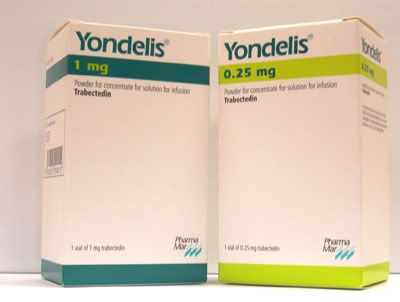
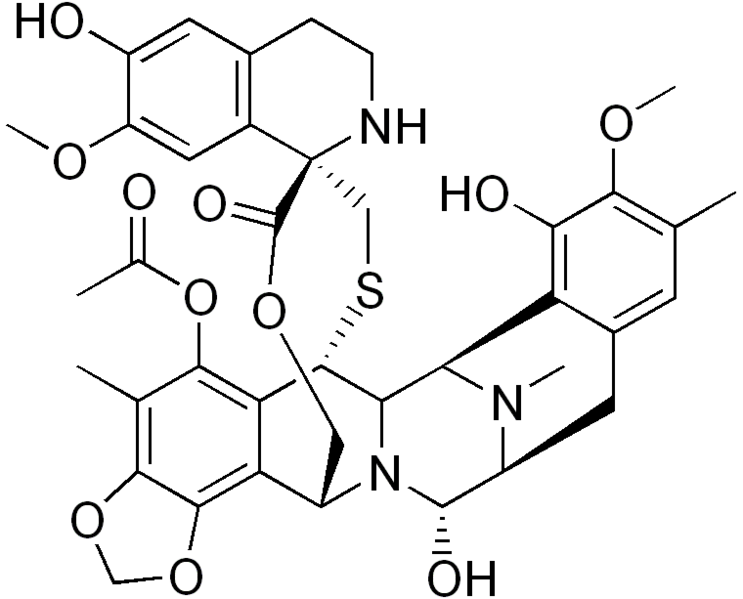
機轉如下:
Trabectedin is a tetrahydroisoquinoline molecule that was originally derived from the Caribbean marine tunicate Ecteinascidia turbinate(海鞘) and is now produced by chemical synthesis.
It binds to the minor groove of DNA, forming trabectedin-DNA adducts that bend DNA towards the major groove; in contrast, other minorgroove binders usually bend DNA towards the site of interaction.
Two of the three fused tetrahydroisoquinoline rings that make up the trabectedin molecule are involved in the minorgroove binding process, whereas the third is likely to be involved in interacting with different DNAbinding proteins located in the DNA adduct area.
The exact mechanism of action of trabectedin is yet to be fully elucidated. It is thought that one of the DNA-binding proteins in the DNA adduct area could be xeroderma pigmentosum, complementation group G (XPG), a member of the nucleotide excision repair (NER) system.
In one study, trabectedin resistance in tumour cells was related to the lack of functional XPG protein, as restoration of XPG in XPG-deficient cell lines by transient transfection of a plasmid containing XPG complementary DNA restored the sensitivity to trabectedin.
Thus, it appears that trabectedin interferes with transcription-coupled NER (TC-NER).
The role of TC-NER is to recognise DNA lesions and remove them from transcribed strands of expressed genes; the excised DNA segment is then replaced via DNA repair synthesis.
It is thought that DNA-bound trabectedin disrupts this process, preventing correction of DNA lesions by TC-NER, and by creating stronger cytotoxic ternary complexes (trabectedin-DNA-XPG) that eventually block the activity of the NER repair system.
Unlike other DNA-interacting agents that require a deficient NER mechanism to exert their activity, trabectedin is effective when the NERmechanism is functional.
The formation of large ternary cytotoxic complexes results in double-stranded DNA break lesions during the S-phase of the cell cycle;
these double-stranded breaks require homologous recombination to repair the damage.The need for homologous recombination may explain the sensitivity to trabectedin of solid tumour cells deficient in one or more proteins involved in this DNA repair process.
Trabectedin induces both transcription- and replication-coupled DNA double-strand breaks and these may be detected as foci of histone H2AX phosphorylated at serine 139 (g-H2AX) that are colocalized with other markers of DNA double-strand breaks (e.g. p53 binding protein 1,meiotic recombination 11 homologue A antibody and the endonuclease rad51).
Trabectedin selectively inhibited transcription of several genes, particularly those that encode the multidrug resistance protein 1, heat shock protein 70 and cyclin-dependent kinase inhibitor p21WAF1/Cip1, thus inhibiting growth of cancer cells and facilitating cell death. TC-NERinduced and von Hippel-Lindau tumour suppressor complex-mediated degradation of RNA polymerase II also appear to contribute to cell death associated with trabectedin.
More than 90% of myxoid/round cell liposarcomas carry a chromosomal translocation that results in fusion of the genes for FUS and CHOP. This fusion plays a causative role in the development of myxoid/round cell liposarcoma, most likely by blocking cell differentiation. Trabectedin appears to block the aberrant transcription activity of fusion proteins related to tumorigenesis, including FUSCHOP protein.In myxoid liposarcoma cell lines that expressed the FUS-CHOP fusion protein,
trabectedin induced activation of the differentiation (i.e. maturation) of myxoid liposarcoma cell lines with type 1, but not type 8, FUS-CHOP fusion in vitro. Activation of differentiation was also evident in tumour samples from two patients with type 1 or type 2 myxoid liposarcoma who had received trabectedin therapy prior to tumour excision.
太多了,簡單的說,就是:
A marine-derived compound which blocks the cell cycle at the G2/M phase by covalently binding to the minor DNA groove, bending the helix toward the major groove and altering DNA transcription. Also alters DNA repair mechanism.
目前研究可以作用在晚期軟組織癌(soft tissue sarcoma)或是對鉑金類藥物有反應之再發性卵巢癌。
另外一個藥物didemnins,也是從海鞘中分離出來的,簡單提一下海鞘,
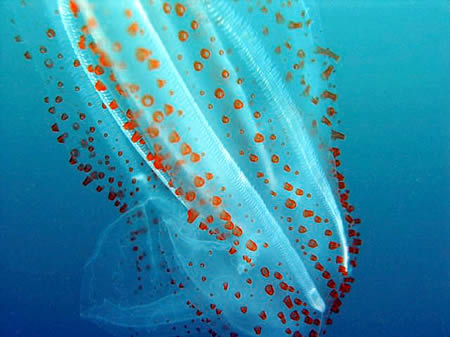
而Yondelis是從下面這種海鞘中分離出來的
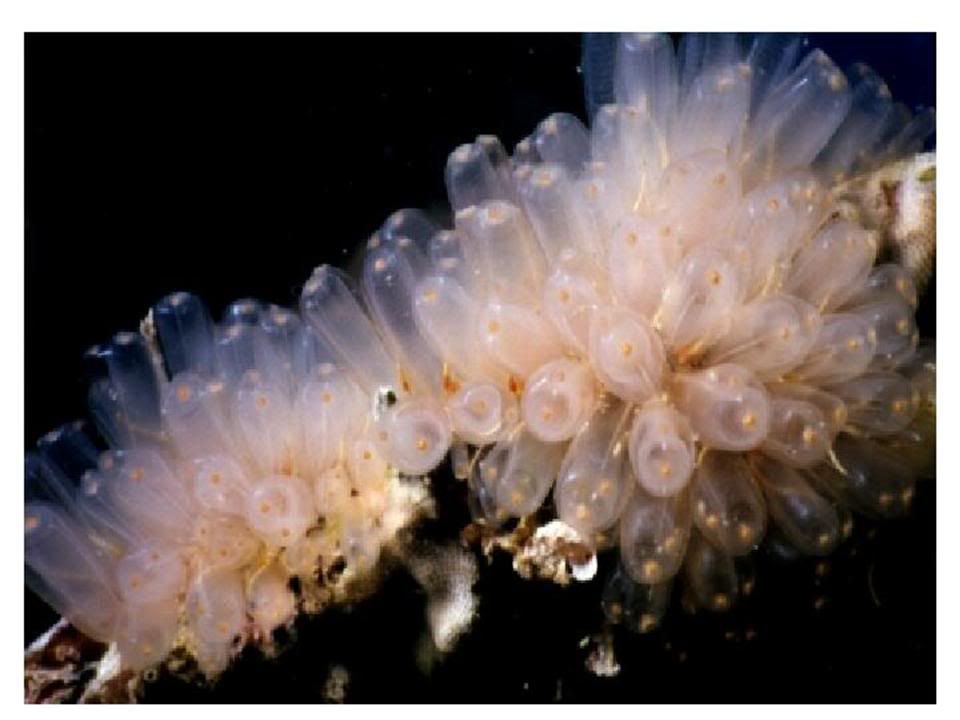
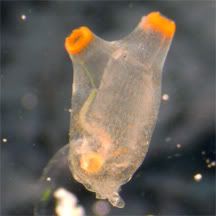
海鞘(學名:Ascidiacea)是脊索動物門尾索動物亞門海鞘綱的總稱,全世界大概1250種海鞘。常見的海鞘有:玻璃海鞘、有柄海鞘、擬菊海鞘等。海鞘又稱海中鳳梨,因形狀像鳳梨而得稱,他常常長在珊瑚礁上面。
科學分類為:
脊索動物門 Chordata,索動物亞門 Urochordata,海鞘綱 Ascidiacea,下分為兩個目:內性目 Enterogona及側性目 Pleurogona。
生物特徵:
海鞘身體呈現壺型或囊型,外層有植物纖維包裹,身體頂部有兩個孔為分別為出水口和入水口。海鞘是通過濾浮游生物和有機物顆粒為生。一旦遇到刺激會通過收縮擠壓身體里的水向外噴出,已到達退敵的目的。
海鞘屬於雌雄同體,其繁殖方式有兩種。其中一種是異體受精的繁殖方式。雌體排出卵子到水中,經過異體雄體排出精子受精後,發育為受精卵。受精卵孵化成幼體後能自由活動,一旦遇到附着物便會附着在上面,開始發育。幼體的尾部逐漸消失。其主要的脊索和神經索部分器官完全消失,只保留其中的一個神經節。然後逐漸發育成熟。還有一種是同體發芽繁殖方式,海鞘成體長出新的繁殖芽,脫落後附着到新的附着物上,重新成長為新的單獨個體。所以有些人誤認為是植物。
從海鞘裡面提煉可以提煉出trididemnum solidum,再講點歷史:1978年美國林哈特(Rinehart)在加勒比海的探險中,自Didemnidae科的海鞘Trididemnum solidum分離出didemnin B,didemnin B是個環狀的depsipeptide,他以質譜、核磁共振等光譜法,配合水解,來決定其胺基酸的次序及立體結構。
看一下WIKI的資料,就可以知道他的族群有A-E,G還有X和Y,結構大概是這樣:
事實上,從海洋中的生物或是植物中做成藥品很早就有了,例如妳常常聽到的Ara-A、acyclovir、AZT、ribivirin都是從海綿中取出來的。
didemnin目前研究是作用在卵巢癌及乳腺癌,具有良好的殺癌細胞效果,但是確有一些後遺症及導致其他疾病的隱疾出現,所以被FDA否決了。
不過不用太難過,相信以現今的醫學技術,這只是一個開端,之後說不定會對他的結構或是藥理、藥化性質有所改善,就可以意外的對某些疾病有效果了。
另外一個也是海鞘做成的藥物是Dehydrodidemnin B,從地中海海鞘Aplidium albicans得到,對肝細胞毒性較didemnin B低,但活性是didemnin B的6-10倍,對血癌、皮膚癌、乳癌、卵巢癌、直腸癌、非小細胞肺癌及淋巴癌均有效
關鍵字:trabectedin ET 743 didemnin yondelis





 留言列表
留言列表
 線上藥物查詢
線上藥物查詢 